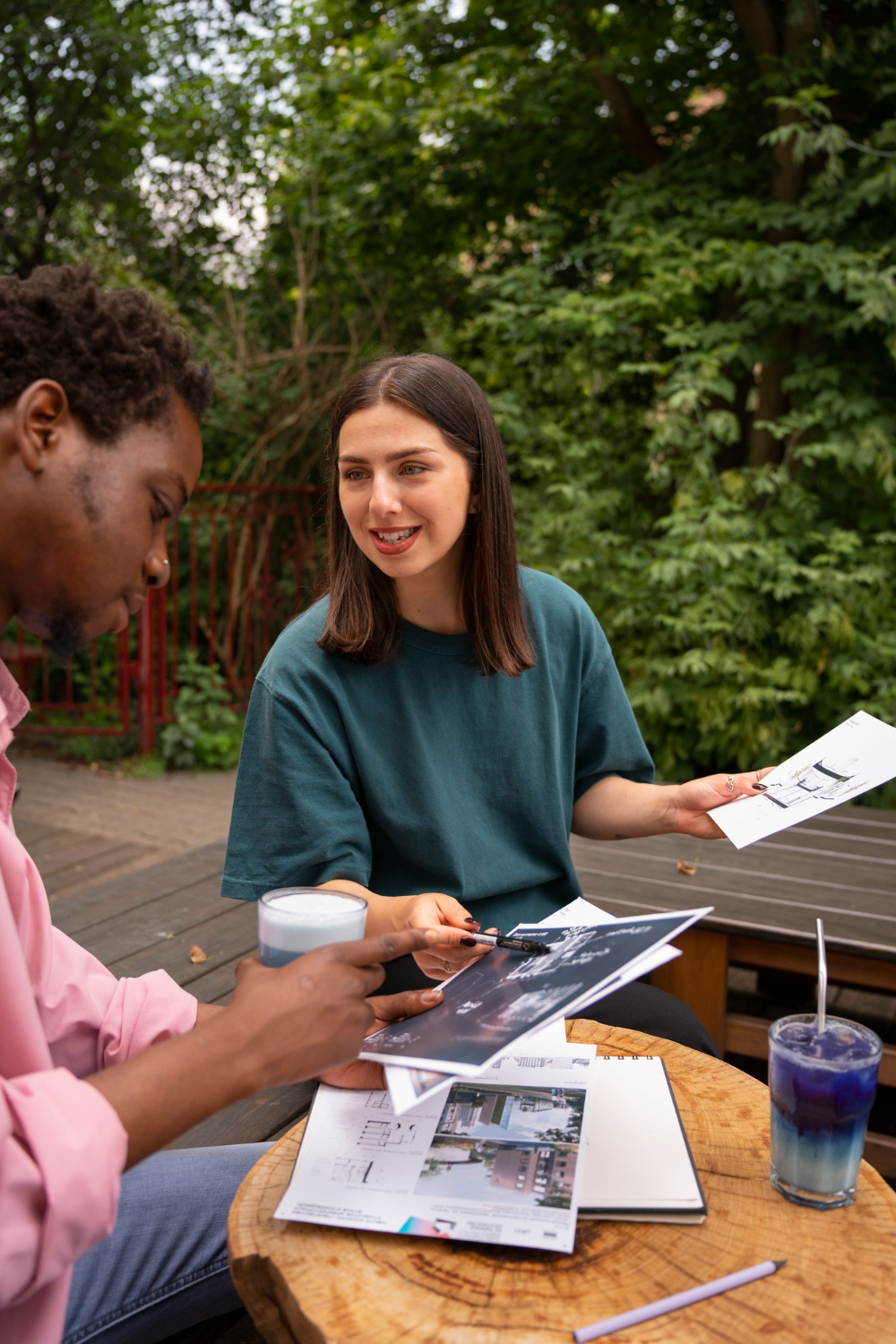
Mündliche Prüfung Klasse 10 - Bildbeschreibung (ESA)
Zielsetzung: Die Schüler:innen trainieren die Beschreibung und Analyse von Bildern, um ihre mündliche Ausdrucksfähigkeit und ihr Präsentationsvermögen für die Abschlussprüfung zu stärken.
Inhalte und Methoden: Die Schüler:innen erhalten ein Bild und lernen eine strukturierte Herangehensweise zur Beschreibung und Analyse. Sie beginnen mit einer allgemeinen Einleitung, gefolgt von einer detaillierten Beschreibung des Bildinhalts. Anschließend interpretieren sie das Bild und äußern ihre persönliche Meinung. Zur Unterstützung werden Redemittel und Satzstrukturen bereitgestellt.
Kompetenzen:
- Strukturierte Bildbeschreibung auf Englisch
- Erweiterung des thematischen Wortschatzes
- Argumentative und reflektierte Bildinterpretation
- Flüssiges, sicheres Sprechen in Prüfungssituationen
Zielgruppe und Niveau: Geeignet für die (mündliche) ESA-Abschlussprüfung im Fach Englisch, sowie für Hauptschulabschluss (HSA) und Berufbildungsreife (BBR).
63 other teachers use this template
Target group and level
Geeignet für die (mündliche) ESA-Abschlussprüfung im Fach Englisch, sowie für Hauptschulabschluss (HSA) und Berufbildungsreife (BBR).
Subjects
Mündliche Prüfung Klasse 10 - Bildbeschreibung (ESA)


Background information
Use the following text as background information on the topic of your picture description. Carefully read the text and mark or write down any relevant information.
Martin Luther King
Introduction
Martin Luther King Jr. was born on January 15, 1929, in Atlanta, Georgia. He was a Baptist minister and a civil rights activist. He is famous for his role in the American civil rights movement in the 1950s and 1960s. King fought for racial equality and justice using nonviolent protest.
Early Years
Martin Luther King Jr. grew up in a middle-class family. His father and grandfather were Baptist preachers. His parents were well-educated, and his father was the pastor of the Ebenezer Baptist Church in Atlanta. King had a happy childhood, but he also experienced racism. When he was six, a white friend told him they could not play together anymore because they were going to segregated schools.
King was a bright student and started college at Morehouse College when he was just 15 years old. During a summer in Connecticut, he saw how black and white people lived peacefully together. This experience made him hate racial segregation even more.
Education and Early Career
King decided to become a minister like his father. He studied at Crozer Theological Seminary in Pennsylvania. He learned about nonviolence from Mohandas Gandhi, an Indian leader who fought for independence without violence. King then went to Boston University and earned a doctorate in theology.
Civil Rights Movement
In 1954, King became the pastor of a church in Montgomery, Alabama. In 1955, he led the Montgomery Bus Boycott. This protest started after Rosa Parks refused to give up her bus seat to a white person. The boycott lasted for over a year and ended when the Supreme Court ruled that bus segregation was illegal.
King founded the Southern Christian Leadership Conference (SCLC) in 1957. The SCLC promoted nonviolent protests to fight for civil rights. King organized many peaceful marches and protests. He believed in nonviolence and love for everyone.
Famous Speeches and Achievements
One of King's most famous speeches is the "I Have a Dream" speech. He gave this speech during the March on Washington in 1963. In this speech, King talked about his dream of a world where people are not judged by their skin color but by their character.
King's work led to important changes in American laws. The Civil Rights Act of 1964 and the Voting Rights Act of 1965 were passed to end racial discrimination and protect voting rights for African Americans.
In 1964, King won the Nobel Peace Prize for his nonviolent fight for civil rights. He was the youngest person to receive the prize at that time.
Later Years and Legacy
King continued to fight for civil rights until his death. He worked on the Poor People's Campaign to help poor people of all races. On April 4, 1968, King was assassinated in Memphis, Tennessee. His death was a great loss, but his work and ideas continue to inspire people around the world.
King's legacy is honored every year on Martin Luther King Jr. Day, a national holiday in the United States. His life and work remind us of the importance of fighting for equality and justice for everyone.

Guide to describing a picture
Carefully read the following guide to describing a picture step-by-step.
Guide to Describing a Picture in English Class
Introduction:
When describing a picture, include visible details and your background knowledge to show understanding of cultural, historical, and contextual elements.
Step-by-Step Guide:
1. Initial Observation:
- General Overview: Describe the setting, main subjects, and overall impression.
- Example: "The picture shows a busy city street during the day with many people walking and a few cars on the road."
2. Detailed Description:
- Specific Elements: Describe main parts in more detail, including people, objects, and actions.
- Example: "In the foreground, there is a woman pushing a stroller. To the left, a group of teenagers is gathered around a street performer who is playing the guitar."
3. Contextual and Background Knowledge:
- Historical/Cultural Context: Relate the picture to relevant historical or cultural knowledge.
- Example: "This scene could be set in a Western city, possibly during the early 21st century, given the modern clothing and vehicles."
4. Interpretation:
- Analyze: Interpret what is happening and its significance, using your background knowledge.
- Example: "The people seem to be in a hurry, which might indicate it is a weekday morning."
5. Personal Reaction and Reflection:
- Express Views: Share your reaction and thoughts about the picture.
- Example: "This picture reminds me of my visit to Berlin, where the streets were always bustling with activity."
6. Connecting to Broader Themes:
- Relate to Issues: Connect the picture to larger themes like social dynamics or environmental concerns.
- Example: "The image raises questions about urbanization and its impact on the environment."
Practice and Preparation:
- Practice Descriptions: Regularly practice describing different pictures.
- Expand Knowledge: Learn about cultural, historical, and social contexts of English-speaking countries.
- Seek Feedback: Share descriptions with teachers or peers for feedback.
Key Points to Remember:
- Start with a general overview.
- Provide detailed descriptions of specific elements.
- Incorporate historical and cultural context.
- Offer interpretations based on your background knowledge.
- Share your personal reactions and reflections.
- Connect the picture to broader themes and issues.
Good luck with your studies and exams!

Grammar
Remember that picture descriptions are done in present progressive. However, change the tense accordingly for talking about background information on the picture.

Vocabulary
Use the following list of vocabulary as a help for your picture description.
Vocabulary list for picture descriptions
- above - über
- below - unter
- next to - neben
- in front of - vor
- behind - hinter
- on the left - links
- on the right - rechts
- in the middle - in der Mitte
- at the top - oben
- at the bottom - unten
- near - in der Nähe von
- far - weit
- between - zwischen
- corner - Ecke
- center - Zentrum
- background - Hintergrund
- foreground - Vordergrund
- to the left of - links von
- to the right of - rechts von
- inside - drinnen
- outside - draußen
- around - um … herum
- close to - nah an

Picture
Now look at the following image in detail and take notes. You should write down anything that you notice about what's shown in the picture and what kind of background information will be important for your description.

Notes

Practising the picture description
Use your notes as well as the vocabulary introduced at the beginning of the worksheet and start practising your picture description. Try talking for about 3-4 minutes.
Once you're quite confident with your talk, present your picture description to your partner. They will fill out the feedback sheet below and give you feedback on what you did well and what you can still improve upon.
| Aspect | Yes/No | Ideas for Improvement |
|---|---|---|
| Introduction |
||
| Detailed picture description Present progressive Vocabulary |
||
| Context Detailed background information Interpretation |
||
| Conclusion |
Sample solution - text and audio file
In the picture I am describing, a middle-aged man is standing against a blurred background. He is wearing a dark suit with a white shirt and a patterned tie. A small pin is visible on his suit lapel, but we cannot see what it is. He is shown from the shoulders upward, and he is looking slightly to his right, which is to the viewer's left.
The man is having a serious and thoughtful expression. His brow is slightly furrowed, and his eyes are wide open and focused. He is looking into the distance, as if he is thinking deeply about something important. His face shows determination and contemplation. The lighting in the photograph is creating subtle shadows on his face, especially around his eyes and cheeks. This adds depth to his features and emphasizes the serious tone of the image. The high contrast highlights the texture of his hair and skin.
His hair is short and neatly combed. The photograph is in black and white, which makes the image more dramatic and timeless. The blurred background is making his face stand out. We cannot see any details behind him, so our attention is fully on him. He is alone in the picture, and he is not interacting with anyone else. His formal attire makes him look dignified and important. The small pin on his lapel might represent something significant, but we cannot identify it.
Now, thinking about who this man could be, I believe he is Martin Luther King Jr. He was a famous civil rights leader in the United States during the 1950s and 1960s. Martin Luther King Jr. was born on January 15, 1929, in Atlanta, Georgia. He grew up in a middle-class family. His father and grandfather were Baptist ministers, and his father was the pastor of the Ebenezer Baptist Church. When he was six years old, he experienced racism when a white friend could not play with him anymore because of segregated schools.
King was very intelligent and started college at Morehouse College when he was just 15 years old. During a summer in Connecticut, he saw how black and white people lived together peacefully. This made him hate racial segregation even more. He decided to become a minister like his father. He studied at Crozer Theological Seminary in Pennsylvania, where he learned about nonviolence from Mohandas Gandhi, an Indian leader who fought for independence without violence. King earned a doctorate in theology from Boston University.
In 1954, he became the pastor of a church in Montgomery, Alabama. In 1955, he led the Montgomery Bus Boycott after Rosa Parks refused to give up her seat to a white person. The boycott lasted over a year and ended when the Supreme Court ruled that bus segregation was illegal. He founded the Southern Christian Leadership Conference in 1957. He organized many peaceful marches and protests. In 1963, he gave the famous "I Have a Dream" speech during the March on Washington, where he talked about his dream of a world without racism.
In this picture, Martin Luther King Jr. is showing his determination and commitment to fighting for justice and equality. His serious expression reflects the challenges he faced and the courage he had. The blurred background might symbolize the focus on his message and leadership. This photograph captures an important moment in history. It reminds us of Martin Luther King Jr.'s role in the civil rights movement. His work led to important changes in American laws, such as the Civil Rights Act of 1964 and the Voting Rights Act of 1965. He won the Nobel Peace Prize in 1964 for his nonviolent fight for civil rights.
In conclusion, the picture shows Martin Luther King Jr. as a strong and dedicated leader. His expression and appearance convey his passion for equality and justice. The photograph helps us remember his life and work, and it continues to inspire people around the world to fight for what is right.